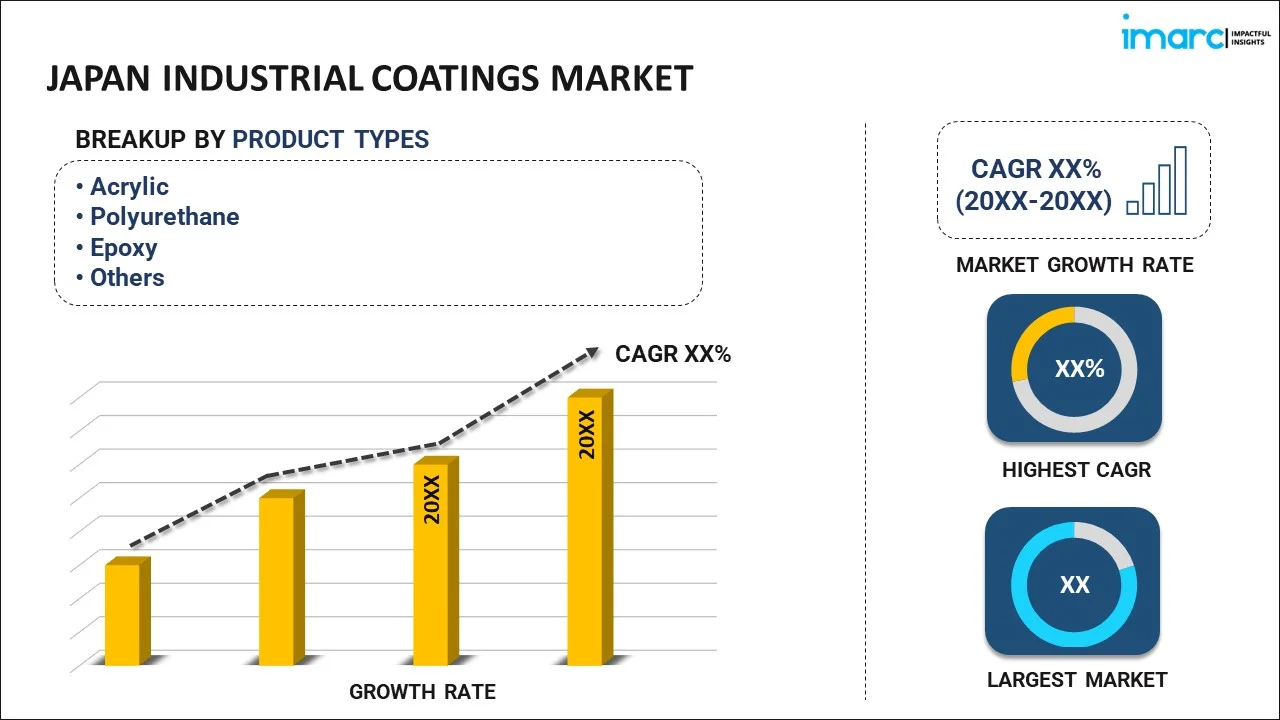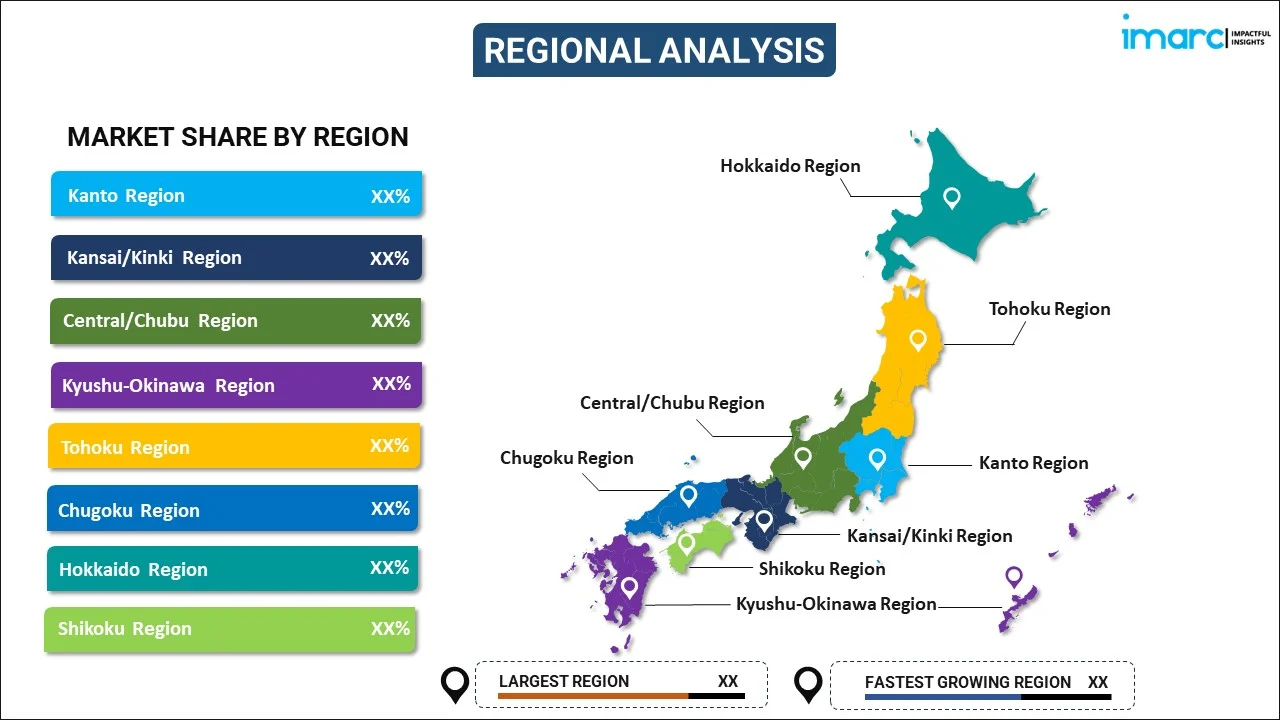
Japan Industrial Coatings Market Report by Product Type (Acrylic, Polyurethane, Epoxy, and Others), Technology (Solvent Based, Water Based, Powder, and Others), End User (General Industry, Marine, Automotive and Vehicle Refinish, Electronics, Aerospace, Oil and Gas, and Others), and Region 2025-2033
Market Overview:
Japan industrial coatings market size reached USD 5.5 Billion in 2024. Looking forward, IMARC Group expects the market to reach USD 8.3 Billion by 2033, exhibiting a growth rate (CAGR) of 4.4% during 2025-2033. The inflating need for environmental sustainability in the automotive sector is primarily driving the market growth.
|
Report Attribute
|
Key Statistics
|
|---|---|
|
Base Year
|
2024
|
|
Forecast Years
|
2025-2033
|
|
Historical Years
|
2019-2024
|
| Market Size in 2024 | USD 5.5 Billion |
| Market Forecast in 2033 | USD 8.3 Billion |
| Market Growth Rate (2025-2033) | 4.4% |
In manufacturing and industrial environments, industrial coatings are employed to serve multiple purposes, which encompass safeguarding surfaces, enhancing visual appeal, and elevating performance levels. These coatings encompass a range of types, including epoxy, polyurethane, powder, and corrosion-resistant coatings. They are specifically engineered to endure and thrive in challenging environmental conditions, resisting the effects of chemicals, corrosion, and the rigors of everyday use. By establishing a protective barrier between the underlying material and potentially corrosive elements like moisture and chemicals, these coatings act as a shield against rust and the deterioration of surfaces. Their contributions extend to the preservation of the durability and operational efficiency of equipment, structures, and various products across diverse sectors, including but not limited to the automotive and manufacturing industries.
Japan Industrial Coatings Market Trends:
In the context of the Japan industrial coatings market, one of the pivotal factors bolstering its growth is the increasing awareness among individuals and companies regarding environmental sustainability. Additionally, the burgeoning demand for eco-friendly and sustainable products is incentivizing manufacturers to embrace greener practices. Concurrently, substantial investments are being made in research and development to engineer coatings that minimize their environmental footprint while upholding high performance standards. Moreover, governing authorities both within Japan and on an international scale are enforcing more stringent regulations concerning volatile organic compounds (VOCs) and hazardous chemicals utilized in coatings. The integration of nanotechnology into industrial coatings constitutes another significant factor fueling market growth. Furthermore, there's a growing demand for coatings that deliver superior protection and durability across diverse industry verticals, further propelling market expansion. The increased utilization of nano coatings in industries like automotive, aerospace, and electronics, owing to their ability to offer thin, lightweight, and highly effective protective layers, is driving demand. Additionally, the widespread adoption of these coatings in healthcare and food processing sectors is positively impacting the market. Besides this, the rising adoption of self-healing coatings, capable of repairing minor scratches and damages within the automotive industry, is anticipated to fuel the market growth over the forecasted period.
Japan Industrial Coatings Market Segmentation:
IMARC Group provides an analysis of the key trends in each segment of the market, along with forecasts at the country level for 2025-2033. Our report has categorized the market based on product type, technology, and end user.
Product Type Insights:

- Acrylic
- Polyurethane
- Epoxy
- Others
The report has provided a detailed breakup and analysis of the market based on the product type. This includes acrylic, polyurethane, epoxy, and others.
Technology Insights:
- Solvent Based
- Water Based
- Powder
- Others
A detailed breakup and analysis of the market based on the technology have also been provided in the report. This includes solvent based, water based, powder, and others.
End User Insights:
- General Industry
- Marine
- Automotive and Vehicle Refinish
- Electronics
- Aerospace
- Oil and Gas
- Others
The report has provided a detailed breakup and analysis of the market based on the end user. This includes general industry, marine, automotive and vehicle refinish, electronics, aerospace, oil and gas, and others.
Regional Insights:

- Kanto Region
- Kansai/Kinki Region
- Central/ Chubu Region
- Kyushu-Okinawa Region
- Tohoku Region
- Chugoku Region
- Hokkaido Region
- Shikoku Region
The report has also provided a comprehensive analysis of all the major regional markets, which include Kanto Region, Kansai/Kinki Region, Central/ Chubu Region, Kyushu-Okinawa Region, Tohoku Region, Chugoku Region, Hokkaido Region, and Shikoku Region.
Competitive Landscape:
The market research report has also provided a comprehensive analysis of the competitive landscape. Competitive analysis such as market structure, key player positioning, top winning strategies, competitive dashboard, and company evaluation quadrant has been covered in the report. Also, detailed profiles of all major companies have been provided.
Japan Industrial Coatings Market Report Coverage:
| Report Features | Details |
|---|---|
| Base Year of the Analysis | 2024 |
| Historical Period | 2019-2024 |
| Forecast Period | 2025-2033 |
| Units | Billion USD |
| Scope of the Report | Exploration of Historical Trends and Market Outlook, Industry Catalysts and Challenges, Segment-Wise Historical and Future Market Assessment:
|
| Product Types Covered | Acrylic, Polyurethane, Epoxy, Others |
| Technologies Covered | Solvent Based, Water Based, Powder, Others |
| End Users Covered | General Industry, Marine, Automotive and Vehicle Refinish, Electronics, Aerospace, Oil and Gas, Others |
| Regions Covered | Kanto Region, Kansai/Kinki Region, Central/ Chubu Region, Kyushu-Okinawa Region, Tohoku Region, Chugoku Region, Hokkaido Region, Shikoku Region |
| Customization Scope | 10% Free Customization |
| Post-Sale Analyst Support | 10-12 Weeks |
| Delivery Format | PDF and Excel through Email (We can also provide the editable version of the report in PPT/Word format on special request) |
Key Questions Answered in This Report:
- How has the Japan industrial coatings market performed so far and how will it perform in the coming years?
- What has been the impact of COVID-19 on the Japan industrial coatings market?
- What is the breakup of the Japan industrial coatings market on the basis of product type?
- What is the breakup of the Japan industrial coatings market on the basis of technology?
- What is the breakup of the Japan industrial coatings market on the basis of end user?
- What are the various stages in the value chain of the Japan industrial coatings market?
- What are the key driving factors and challenges in the Japan industrial coatings?
- What is the structure of the Japan industrial coatings market and who are the key players?
- What is the degree of competition in the Japan industrial coatings market?
Key Benefits for Stakeholders:
- IMARC’s industry report offers a comprehensive quantitative analysis of various market segments, historical and current market trends, market forecasts, and dynamics of the Japan industrial coatings market from 2019-2033.
- The research report provides the latest information on the market drivers, challenges, and opportunities in the Japan industrial coatings market.
- Porter's five forces analysis assist stakeholders in assessing the impact of new entrants, competitive rivalry, supplier power, buyer power, and the threat of substitution. It helps stakeholders to analyze the level of competition within the Japan industrial coatings industry and its attractiveness.
- Competitive landscape allows stakeholders to understand their competitive environment and provides an insight into the current positions of key players in the market.
Need more help?
- Speak to our experienced analysts for insights on the current market scenarios.
- Include additional segments and countries to customize the report as per your requirement.
- Gain an unparalleled competitive advantage in your domain by understanding how to utilize the report and positively impacting your operations and revenue.
- For further assistance, please connect with our analysts.
 Inquire Before Buying
Inquire Before Buying
 Speak to an Analyst
Speak to an Analyst
 Request Brochure
Request Brochure
 Request Customization
Request Customization




.webp)




.webp)












